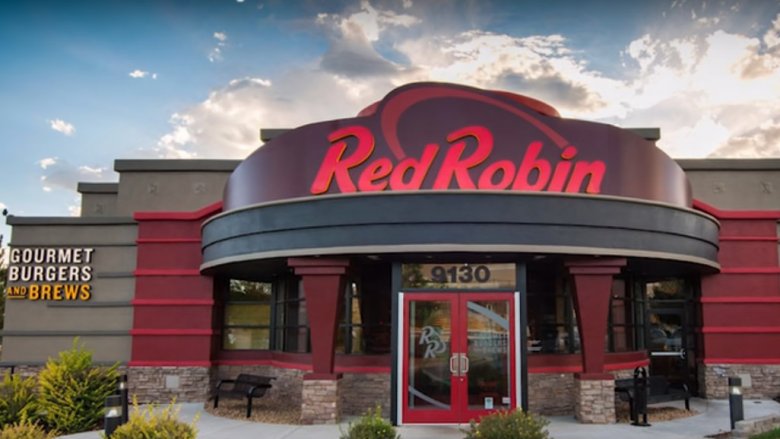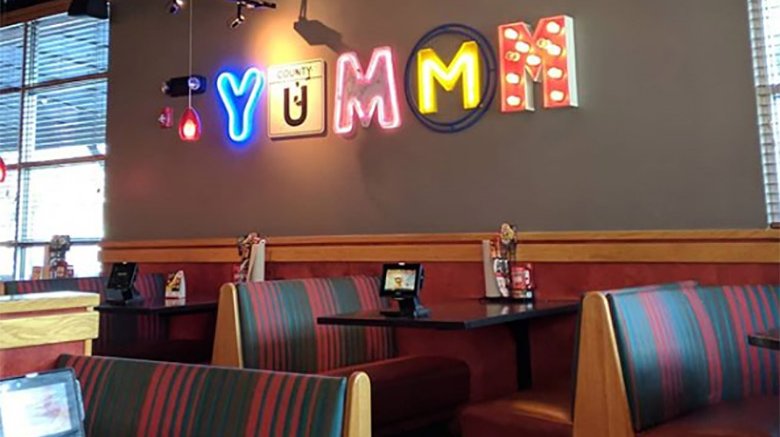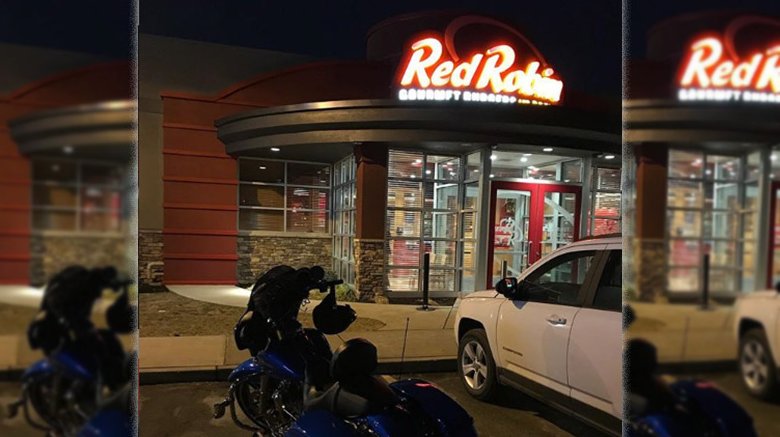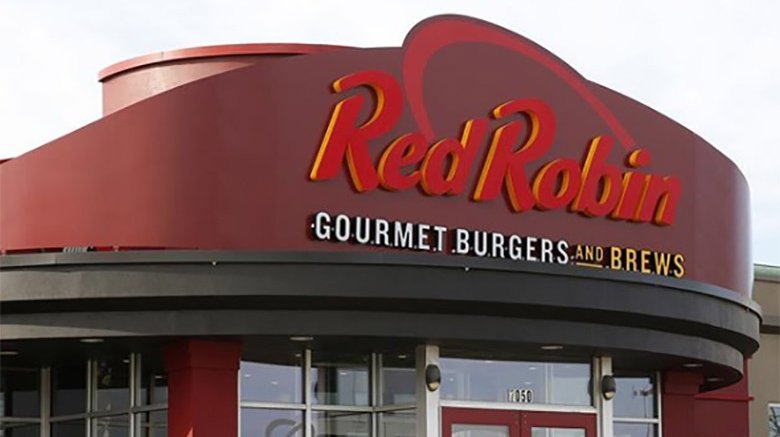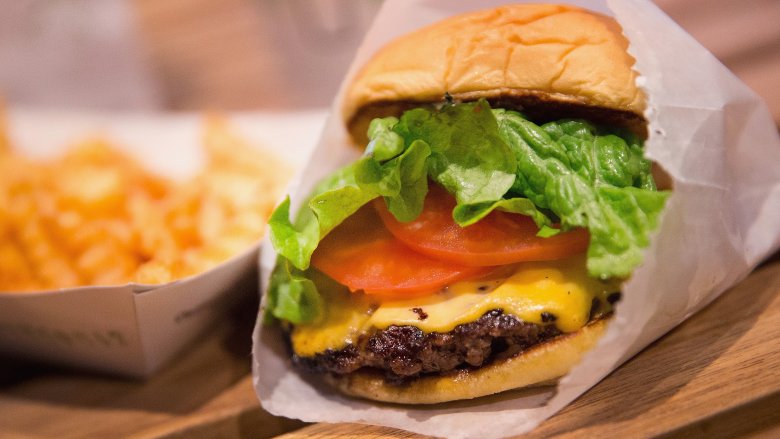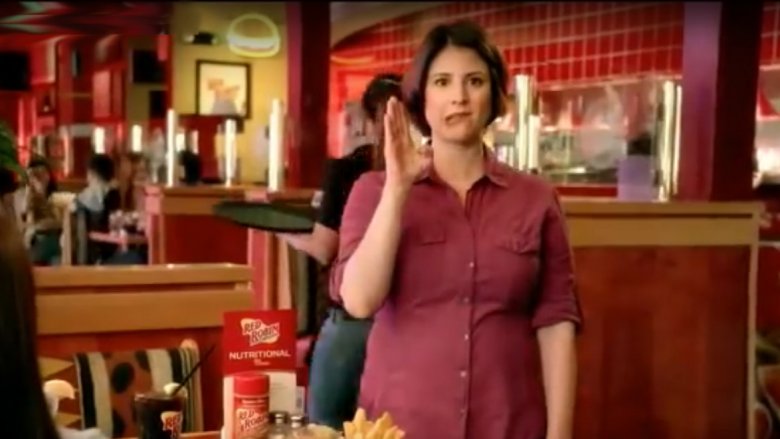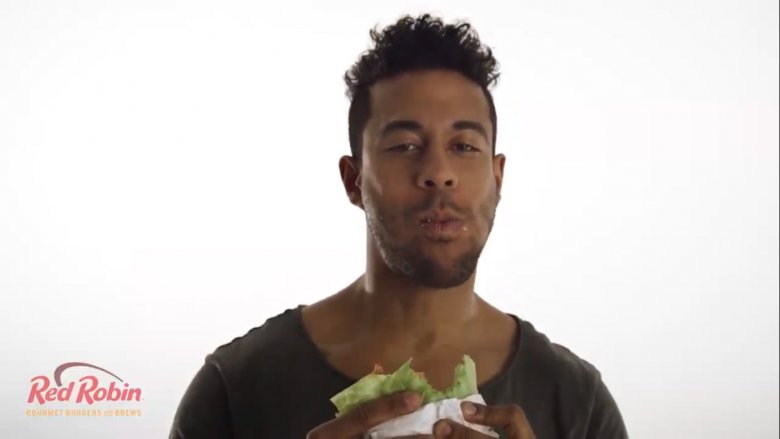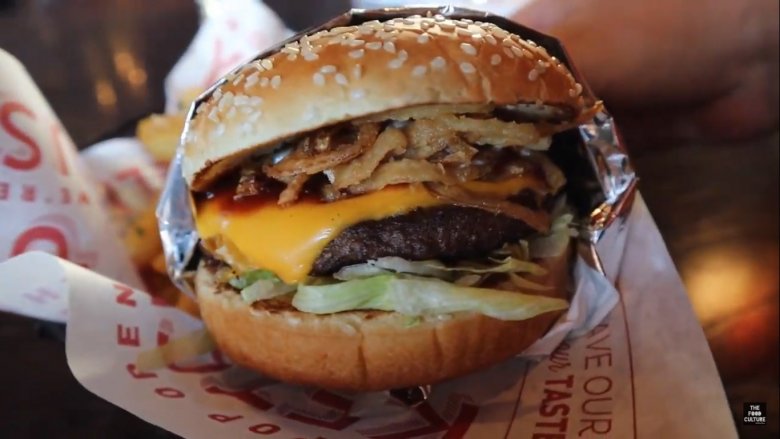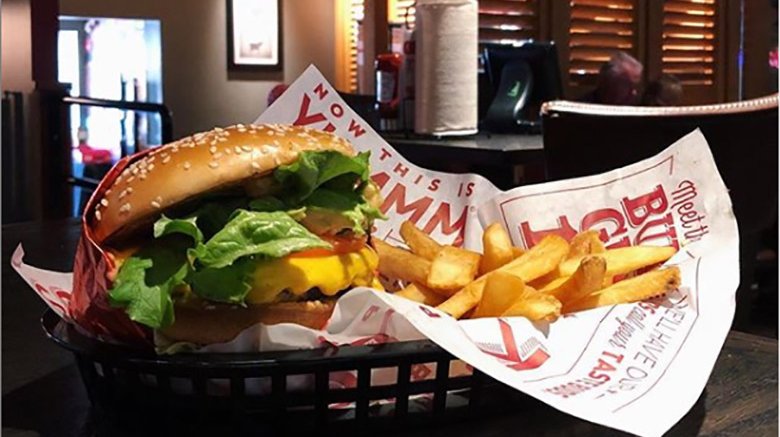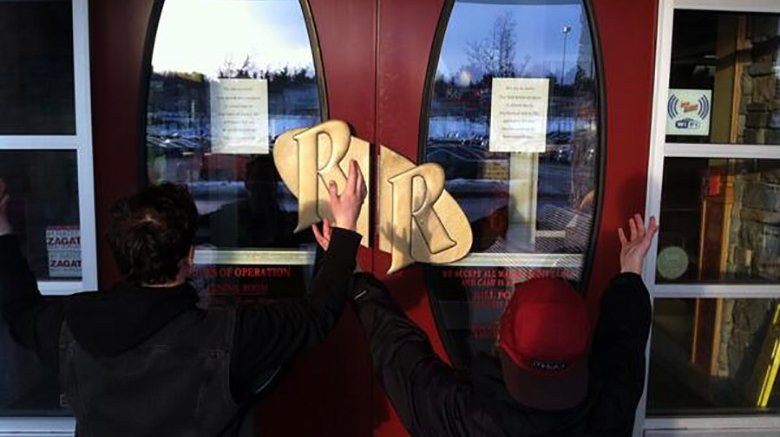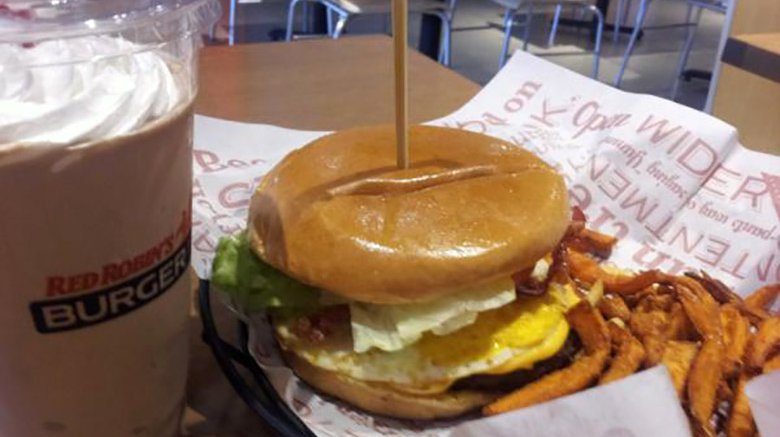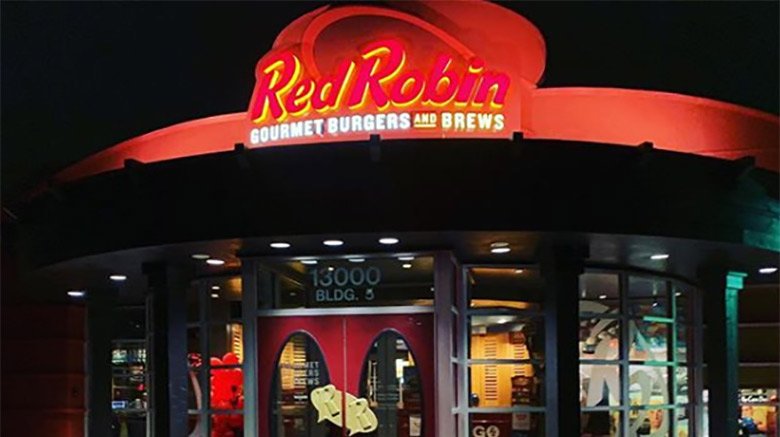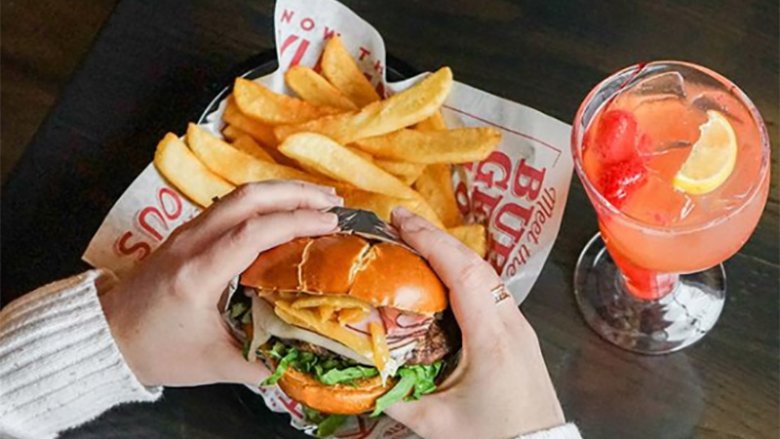The Real Reason Red Robin Is Struggling
It's safe to say that the burger is a staple of the American diet. Collectively, the United States eats close to 50 billion of them a year and there's no shortage of places to grab a burger. One of the most popular burger chains, Red Robin, has 573 locations as of early 2019, and has been serving up its gourmet burgers for nearly a half century. Even with all that burger expertise under its belt, the burger business hasn't been especially great for Red Robin recently. It's never good when experts use the word "nosedive" when talking about sales performance. And they weren't wrong — the company ended 2018 with a $10.6 million loss. For Red Robin investors, those numbers are about as appealing as a plate of cold, soggy fries.
Times weren't always bad for this Colorado-based burger chain, though. The company flourished in the 1980s and expanded into Canada, and by the end of the 2000s they had opened their 400th restaurant and were regularly claiming "best burger" awards.
Why Red Robin is struggling today involves a number of issues. It's time to investigate what's going on with this burger mainstay and find out what they're doing to put their beef back on the business track. These are the real reasons Red Robin is struggling.
Mall locations are dragging them down
Red Robin had a tough time getting people in the door and into its booths in 2018. In fact, its dine-in traffic for the year was down 4.2 percent. Red Robin's CEO and president Denny Marie Post said the decline in dine-in customers was "the first and primary issue facing" the company. But some locations were feeling that hurt even more than others.
The dine-in decline was particularly apparent for Red Robin when it came to the company's mall locations, where sales were down 5.5 percent versus only a 3.6 percent drop in non-mall restaurants. "Those locations make up about 16 percent of our base, and they are disproportionately represented in the bottom performers on dine-in traffic and off-premise sales," Post added.
"We continue to focus on improving the performance of certain challenged mall locations through rent reductions and marketing and sales-building strategies to improve profitability," Post explained, before confirming that they may consider closing some mall locations. "We've seen this get worse now three quarters in a row.... [the decline] has us looking with greater urgency at that element of our portfolio."
Long wait times have turned off customers
No one wants to wait 20 minutes for a table and another 20 for their meal. Red Robin's wait times have increased and it's driving away the company's potential dine-in customers and sending them off to find their burger fix elsewhere.
The company estimates that as much as 75 percent of its drop in dine-in traffic happened during peak hours and increasing wait times are very much to blame. "We're seeing dine-in demand that we're not capturing," said Post. "People are showing up at our doors and the walkaway rates are higher, the length of time they're being asked to wait is marginally longer."
The time for a customer to get their meal once they've ordered increased by a minute, as did the time to be seated. A mere 60 seconds might not seem like a lot, but it adds up and results in a pretty big increase of customers walking away. Post said that year-after-year, those increases pushed Red Robin's walkaway numbers up 85 percent.
It doesn't take a business genius to figure out that when that many people walk in your doors and then walk right back out, you had better change up the game plan quickly or your days are numbered.
Relying on technology brought new labor problems
Red Robin's efforts to streamline its business with technology haven't always worked out in the restaurant's favor.
Faced with the minimum wage increases that took effect in 18 states in January 2018, Red Robin opted to offset the rise in labor costs by ditching all of its busboys. The solution was to use a kitchen display technology system dubbed Maestro that reshaped the server's role. It was now the server's duty to clean the table. Spoiler alert: things didn't pan out smoothly.
Initially, industry insiders praised the move, as it would save Red Robin $8 million over one year's time. However, it resulted in a slowdown of tables being cleared and a jump in guest complaints. "Unfortunately, we did not execute this well at all," Post confessed before adding "...it impacted us most during peak periods." Cutting out a job position and shifting the weight over to servers might have saved the company money up front, but it only increased the number of people choosing not to dine in-house.
Fast food burgers are getting better
Burgers are big business and the industry keeps growing to satisfy Americans' burger cravings. According to Food Business News, 44 percent of sandwich sales in the United States in 2016 were attributed to burgers. The burger industry has seen both a rise in chains as well as independent burger joints and that means more competition for restaurants like Red Robin. There may simply be too much burger business competition out there and according to analysts, Red Robin is struggling to compete.
While each market may have its own independent chains to contend with, the big competition on the block is mostly coming from fast food chains offering more premium burgers. For example, McDonald's rolled out their "Signature Crafted Recipe burgers" and Jack in the Box launched a ribeye burger with a red wine glaze (Yes, you read that correctly.) The beefed up burgers from fast food competitors contributed to Red Robin's stock dropping 20 percent in late 2017.
Whether or not the premium burgers from the fast food competition beat Red Robin in taste is up for your own taste buds to decide. However, many of the fancy fast food burgers come in a few bucks cheaper than most of RR's gourmet burgers.
A commercial dissing vegetarians backfired horribly
Making an effort to bring in new customers for your restaurant is always a great idea. Choosing to do so by insulting them is almost always a bad one. Alas, that's the pitfall Red Robin stumbled into when they decided to go after vegetarians and let them know about their veggie burger in 2013.
The commercial basically went like this: an actress mentions Red Robin's 24 burger varieties and points out that they even have a garden burger "just in case your teenage daughter is going through a phase." Cue internet outrage...
As you can probably guess, vegetarians didn't like having their lifestyle compared to a teen girl's flavor of the week eating habits, and took to Facebook to show their disapproval. "I don't think I'll be giving you another shot after such a disrespectful and callous ad," read one message.
Responding to the issue, Red Robin's communications chief, Kevin Caulfield said the commercial was planned to be pulled and would no longer be on the air. Red Robin still has a veggie burger on the menu, but they may have lost part of the customer base they hoped would buy it.
Successful marketing has been an uphill climb
Having strong advertising and a solid marketing tactic is essential for a burger chain that's looking to compete on a national scale. Perhaps it was the backlash from the garden burger ad, or maybe it was the two disappointing sales quarters back-to-back. Either way, in 2016 Red Robin split with the ad agency it had been using since 2013 and went looking for a new group that could creatively spread its burger gospel.
Red Robin had decided that it wanted its advertising to help them alter their "family-only" image and bring in the hip adult crowd. The first step was hiring the KBS agency and building on the "Red Robin... Yumm" tagline the restaurant had been using since 2010 with "Let's Burger." That'll bring in the cool crowd, right? Next came a campaign that mocked man-buns to promote their bun-less burger because, hey, hating on man-buns was the cool thing to do in 2017.
Considering that Red Robin ended 2017 on a downward slide, the creative relationship with KBS obviously wasn't all that RR hoped it would be. After just a year and a half of working with the agency, Red Robin was back on the market in search of a new creative ad agency.
Even by burger standards they've been labeled unhealthy
Most people know that the average cheeseburger isn't typically classified as health food. A half pound of red meat, topped with fried onions, cheese, and barbecue sauce with enough sugar to bring about a cavity just isn't going to win any health awards.
As long as every other competitor is serving up burgers that are on par with being just as unhealthy as yours, there's probably not much cause to worry about people making a fuss. It's when a burger on your menu takes the title of "America's most unhealthy meal" that there's cause for concern. Red Robin's Monster meal was a two patty beefy beast that included bottomless fries and a milkshake. Red Robin's senior vice president at the time, Denny Marie Post, said it "combines some of our most indulgent items into one meal."
That's fine and all, but when you'd have to walk for 12 hours — a brisk walk at that — to burn off the calories, maybe it's time to scale back the "indulgent items" a bit.
The bargain deals weren't good for profits
Offering a sweet deal that gets customers in the door and buying your product is a great tactic that's been used for probably just as long as restaurants have been in business. It backfires, however, when the deal you're offering is a little too good — and when not enough patrons are ordering your other higher priced menu items.
Red Robin's Tavern Double Menu was their solution to bringing customers in who might feel that hamburger prices were simply spiraling out of control. In contrast to their $9 higher priced burgers, the Tavern Double Menu aimed to give customers a cheaper burger at $6.99. It's a good deal... just a little too good.
The problem arose when people began opting to order the cheaper burgers more often than not. Orders of the Double Tavern burgers jumped from nine percent of orders to 15 percent and eventually contributed to a drop in the average check price and 2.6 percent decline in same-store sales. D'oh!
Health scares are never good for business
Juicy burgers with piled on toppings served promptly at a fair price will always be good for a restaurant's business. When there's a chance that those burgers come with a side of food poisoning, well, business seems to dry up worse than a well-done beef patty. Just ask Jack in the Box about their 1993 E. coli incident that made over 700 people sick and killed four of them. It cost the company millions and took years for them to earn back the public's trust. Following the Jack in the Box burger nightmare, Red Robin started asking customers exactly how they would like their burgers cooked. In the past, every burger was cooked medium rare, unless the customer specified otherwise.
In 2014, Red Robin was facing down its own health scare when news broke that an employee in Missouri potentially exposed 5,000 people to Hepatitis A. Red Robin caught a lucky break that the disease didn't spread to any customers, but the close call still did some damage. Red Robin ultimately agreed to a settlement of $325,000 with those customers who had to get shots being paid $10,000 in "special damages."
Red Robin's health scare may not have resulted in any children dying, but hepatitis headlines definitely aren't the sort of press any restaurant wants associated with its food.
A rebranding effort failed
If you hadn't noticed, the fast-casual restaurant trend is on the rise and everyone from fast food restaurants like McDonald's to sit-down places are trying to jump on the bandwagon. Red Robin is no different and in 2011 attempted to stake its own claim in the fast-casual marketplace by launching a fast-casual offshoot called Burger Works. Y'know, just in case a regular Red Robin was a little too fancy for some customers. The burgers were a little cheaper and the restaurants a little smaller, but unfortunately for Red Robin — so were the profits.
After five years of trying the Burger Works experiment in, Colorado, Chicago, and Washington D.C., Red Robin pulled the plug on nine locations and re-branded the rest because of poor performance. The concept was launched to compete with other fast casual chains like Five Guys and Smashburger, but the new concept wasn't able to differentiate itself enough from a traditional Red Robin, according to a company spokesperson. The story of Burger Works came to a close with some locations eventually being renamed Red Robin Express.
They've had some legal troubles
Red Robin may be getting high praise from customers for its burgers, but it hasn't always gotten kudos from its employees. At least not at several Pennsylvania locations, anyway.
In 2014, the Lehigh Valley Restaurant Group Inc. which owns and operates 21 Red Robin restaurants across Pennsylvania was hit with a lawsuit that ended with a $1.3 million settlement for mishandling tips. The lawsuit claimed that over the course of almost two years, the Red Robin restaurants were in violation of federal wage law because they required servers to share tips with kitchen workers who were being illegally paid less than minimum wage. LVR Group made a bid to have the case dismissed but the request was rejected because Red Robin couldn't properly show that kitchen workers were covered by the tip credit provision.
The suit may have only involved a certain market for Red Robin, but it's also the sort of bad press that very well may send burger-lovers in the Pennsylvania market (or beyond) looking for other dining options.
They're halting growth to refocus
As we've laid out, the past several years have been a bit of a two steps forward, three steps back ride for Red Robin. Even when the chain recognized its problems, Red Robin seemed to struggle when it came to nailing the rebound. "For now, we are, by no means, pleased with our performance through Q3," CEO Denny Marie Post said in November 2018. Same-store sales weren't great for Red Robin in the first half of 2018, but they only got worse as the year came to a close and the company ended the year with sales continuing downward.
When sales continue to drop not just in one restaurant but across the board, expanding into other markets isn't exactly a smart idea. And for that very reason Red Robin ended 2018 by halting any plans to open new restaurants. Post said that the company's efforts in 2019 would be "centered on markets" where several Red Robin restaurants already exist.
That definitely seems like a wise game plan for Red Robin, but the question is, what will that refocused energy look like?
They have a game plan for winning guests back
Red Robin knows they have a few wrinkles to iron out. In August 2018, the company said that they would be putting their hosts through new training and increasing staff to help with quicker table turnover. While this didn't translate to an immediate comeback for Red Robin, they haven't given up hope either.
Post said the changes put into effect that also included more limited time-only burgers were yielding positive results, but there's more to the equation if they want to continue regaining their momentum from years ago. Part of Red Robin's battle plan for boosting its sales seems to include a $10 bundle meal that's available only for dine-in customers and a new takeout initiative.
OK, not bad, Red Robin, but what else ya got?
The burger chain is attempting to tackle its long wait times by giving its servers "handheld devices" to relay orders to the kitchen. The company also said they plan to revamp the menu to cut down on the sales drop from its Tavern burgers. Finally, if you weren't aware that Red Robin has a burger bar catering business, well, they do and it's gangbusters! The catering business increased from $1 million in 2017 to $11 million in 2018, so they're definitely going to try and keep that momentum going.
